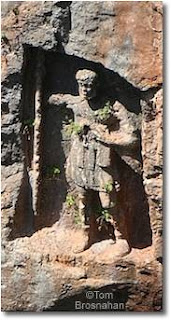•Near Kizkalesi, huge walls of a mammoth temple of Zeus
•Descend 288 steps to the Byzantine chapel in the caves mouth. Huge mouth of cave. Another 70 steps takes you to a flat area below the chapel, yet another 97 steps and you are down into the cave itself. Heading out of the cave is daunting : 400 steps to go to the rim
•The cavern of Hell : 100 m uphill from heaven is a smaller depression with steeper sides, 30 m in diameter and 120 m deep.
•The 2 caves figure prominently in Greek myths according to which Typhon, a fire-breathing 100-head dragon battles Zeus. Zeus is defeated and imprisoned in these chasms. Hermes and pan rescue Zeus who goes after Typhon again, defeats him and buries him in the earth, but he issues with fire from Mt. Etna.
•Kizkalesi – Korykos – Kanytelis
•Kizkalesi : maidens castle 150 m off shore, crusaders castle
•Korykos : onshore castle
•
•Elaioussa – Sevaste : roman-byzantine necropolis at Kanytelis
•
•Elaioussa –Sevaste : just off the highway in the modern city of Ayas are the ruins
•Elaioussa (or Elaeousa, olive) was founded in the 2nd cent AD and flourished by raising and exporting olives and olive oil.
•Archelaus, king of Cappadocia founded a new city near Elaioussa and called it Sebaste (Augusta) in honor of Augustus.
•Elaiussa – Sebaste thrived in the 1st cent. AD and continued through the Byzantine period, but in the 550s as the nearby city of Corykos flourished, Elaiussa-Sebaste lost importance and gradually abandoned. The city ruins excavated by Italians since 1995.
•A small 2nd cent theatre with only 23 rows of seats. Near ruins of agora. Not far away ruins of an extensive necropolis.
•Extensive ruins of the roman-byzantine city east of Kizkalesi
•A yawning chasm at the center of the city, a huge limestone sinkhole surrounded by the ruins of ancient buildings
•Deep in the chasm carved into the rock are high reliefs of a roman soldier and a group of people. further uphill extensive necropolis
•Soloi ( Pompeiopolis), founded in 700 BC by Rhodos
•Solecism: a dialect was a corrupted form of attic Greek
•Mersin (Zephyrion), natural harbor, coins, molybdenum from mines at Coreyra
•Erdemli (Mersin) : nearby places of interest – many, many
•Imirzeli : Hellenistic city with church, tower, houses
•Catioren : a Hellenistic city with temple of Hermes









No comments:
Post a Comment